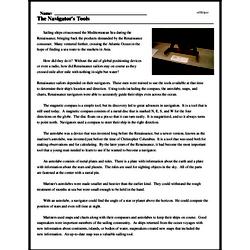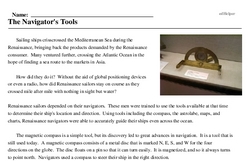The Navigator's Tools
Sailing ships crisscrossed the Mediterranean Sea during the Renaissance, bringing back the products demanded by the Renaissance consumer. Many ventured further, crossing the Atlantic Ocean in the hope of finding a sea route to the markets in Asia.
How did they do it? Without the aid of global positioning devices or even a radio, how did Renaissance sailors stay on course as they crossed mile after mile with nothing in sight but water?
Renaissance sailors depended on their navigators. These men were trained to use the tools available at that time to determine their ship's location and direction. Using tools including the compass, the astrolabe, maps, and charts, Renaissance navigators were able to accurately guide their ships even across the ocean.
The magnetic compass is a simple tool, but its discovery led to great advances in navigation. It is a tool that is still used today. A magnetic compass consists of a metal disc that is marked N, E, S, and W for the four directions on the globe. The disc floats on a pin so that it can turn easily. It is magnetized, and so it always turns to point north. Navigators used a compass to steer their ship in the right direction.




